Sigma C 17-70 mm f/2.8-4.0 DC Macro OS HSM
3. Build quality and image stabilization
The new Sigma compares favourably with its competitors – in fact only the Sony/Zeiss can compete with it when it comes to the parameters. The Zeiss is a bit slower than the Sigma but it provides a wider focal range and at both ends. The Pentax and the Nikkor feature very similar focal ranges but their aperture fastness is much worse than that of the Sigma. The Nikkor is physically the lightest of all but, compared to the Sigma, it lacks the image stabilization. So officially the Sigma has everything it takes to be a great lens: a fast aperture, a useful focal range, sensible dimensions and weight plus the image stabilization and the HSM motor.
In the photos below there is a comparison between the new Sigma and its oldest version which was a bit slower, without any image stabilization system or the HSM motor. It is clear that both lenses don’t differ much when it comes to their physical dimensions. The casing design of the new lens is very stylish and, in my humble opinion, a step in the right direction. In fact the only step backwards is the reproduction scale which, in the oldest lens was the best, providing a very useful macro mode.
Please Support UsIf you enjoy our reviews and articles, and you want us to continue our work please, support our website by donating through PayPal. The funds are going to be used for paying our editorial team, renting servers, and equipping our testing studio; only that way we will be able to continue providing you interesting content for free. |
- - - - - - - - - - - - - - - - - - - - - - - - - - - - - - - - - - - - - - - - - - - - - - - -
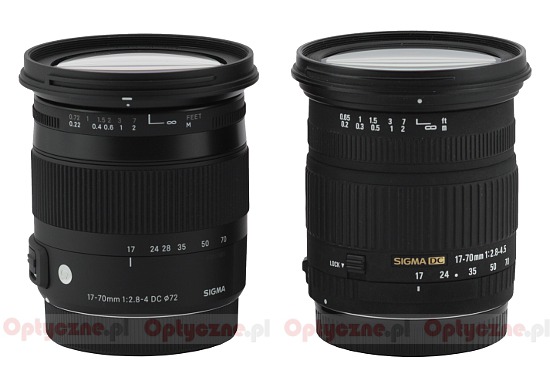 |
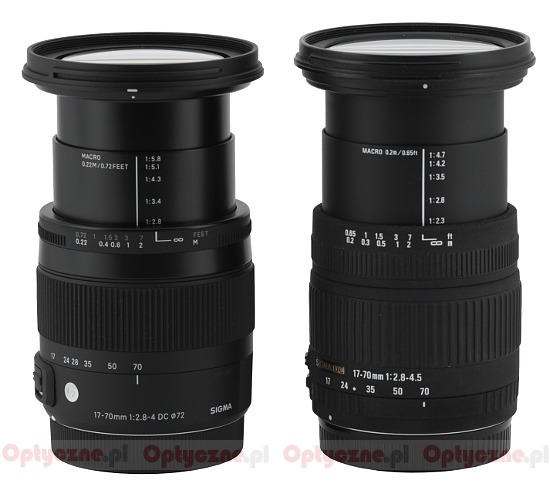 |
The tested lens starts with a metal mount which surrounds contacts and a rear element, 22 mm in diameter. The element is situated on the same level as the mount when you set the focal length at 17 mm. With the increase of the focal length value it hides inside an inner tube, at the maximum focal length being already situated over 3 cm deep. Unfortunately with the shift of the element the tube reveals some electronic pieces and badly blackened parts inside the casing.
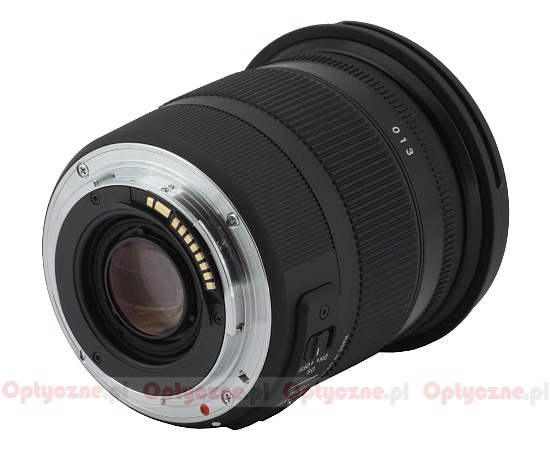 |
On the proper body of the lens, right next to the mount, you can see an inscription with its name and the parameters. On the left there is a ‘C’ mark from the word ‘Contemporary’; a bit further there is a white dot, making the alignment with a camera easier, and two switches. The first of them is used to choose the focusing mechanism working mode (AF/MF), the second one controls the optical stabilization (OS On/Off).
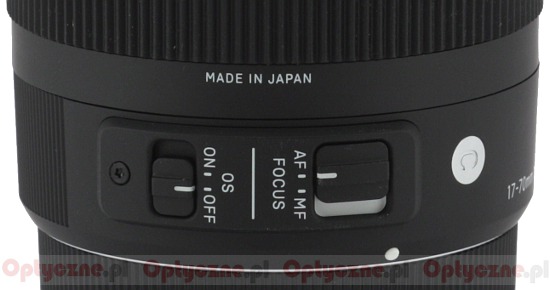 |
The next element of the casing is a zoom ring, 3 cm wide. Most of it is occupied by rubber ribbing under which there are focal length markings at 17, 24, 28, 35, 50 and 70 mm and an inscription “Made in Japan”. The ring moves smoothly and evenly, being properly damped throughout its working range. What’s interesting, this time Sigma decided not to add a switch to block the focal length change. As in the folded position, at 17 mm, the front element system doesn’t extend under its own weight the decision was right. What’s more, even a vigorous shaking of the camera with the lens attached didn’t make it extend uncontrollably.
A manual focus ring is not as small as it seems while looking only at the photos. It is 16 mm wide and most of its surface is perfectly smooth. There are some ribs and a distance scale, expressed in meters and feet. The ring works only in the MF mode; in the AF mode the adjustments are impossible. The usefulness of the ring is low because running through the whole distance scale (quite significant by the way because of a semblance of a macro mode) needs a turn through only 40 degrees.
Smaller dimensions than in the case of its predecessor and a ring without the FTM option make the usage of this lens problematic for the owners of bigger hands. If you want to hold the camera and the lens comfortably in two hands you often put one of them in such a way that the fingers are placed on the focus ring which moves underneath when the autofocus is switched on. It is neither pleasant nor comfortable.
The next part is the front element system, positioned on a telescopic tube made of plastics. When you pass to 70 mm focal length the lens increases its dimensions by 4 cm – then you can see a reproduction ratio scale at a given focal length. The telescopic inner tube looks solid enough, without any tendency to bending or wobbling sideways.
The front element is 57 mm in diameter, surrounded by an engraved inscription with the name, the parameters and the place of production of this lens. There is also a non-rotating filter thread with a diameter of 72 mm. On the very edge you can find a hood thread.
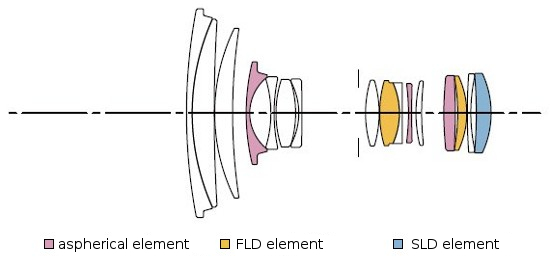 |
A very well done predecessor of this lens was launched not so long ago because at the end of 2009; it featured 17 elements positioned in 13 groups. The new model has 16 elements in 14 groups – the number of elements has gone down but the number of special elements actually increased. The previous model had one SLD low dispersion element and three aspherical ones; the new instrument has three aspherical elements but also additionally one SLD glass element and two FLD elements, made of glass with the properties of fluorite. The lower number of elements and a new casing allowed to decrease the weight from 535 to 470 grams; the length was reduced from 89 to 82 mm. The properties of the aperture changed as well. The number of aperture blades remained the same – seven - but now you can close the aperture to the value of f/22 regardless of the focal length. In the case of its predecessor that value could be changed from f/22 to f/32.
Another feature that can be compared to the predecessors are changes of aperture, depending on the focal length. When you look at the performance of the previous model you can find out that in fact nothing changed. Compared to the first and the oldest version the same aperture you get only in the range from 17 to 28 mm. For longer focal lengths the new models offer bigger relative apertures.
|
|
|
|
|
|
|
|
|
|
| Sigma 17–70 mm f/2.8–4.5 DC Macro |
|
|
|
|
|
|
|
|
| Sigma 17–70 mm f/2.8–4.0 DC Macro OS HSM |
|
|
|
|
|
|
|
|
| Sigma C 17–70 mm f/2.8–4.0 DC OC HSM |
|
|
|
|
|
|
|
|
Buyers get both caps and a petal-type hood in the product bundle.
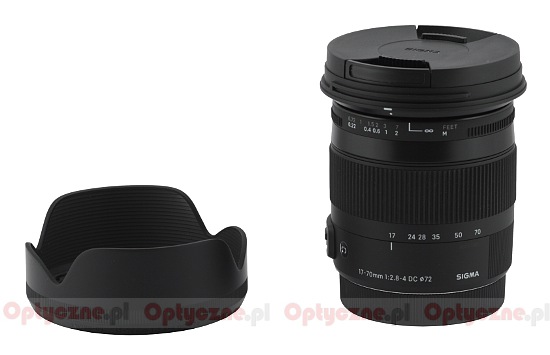 |
Optical stabilization
The producer ensures that the optical stabilization system (OS), used in the Sigma 17-70 mm OS, is as efficient as 4 EV. We decided to check that claim. We set the focal length at 70 mm and, for every available exposure time, ranging from 1/100 to 1/2 of a second, we took several dozen photos with the stabilization switched on and off. Then we calculated the percentage of blurred photos for every time of exposure. The appropriate graph, showing that percentage, correlative with the exposure time expressed in EV (and the 0 EV point corresponds to 1/80 of a second), is presented below.
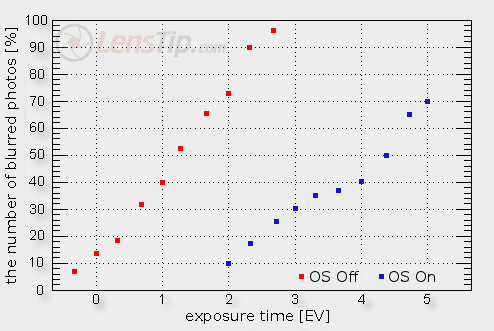
As you see the maximum distance between both curves reaches a bit over 3 EV. It is a very good result for such an amateur lens because the level of 4 EV is reached mainly by expensive, top-of-the-range constructions for the professionals. It is also a similar result to that reached by this lens’s predecessor.






